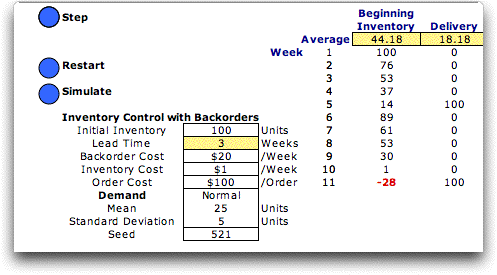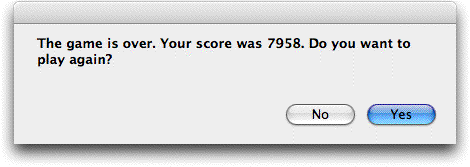|
|

This game involves the stochastic inventory
situation illustrated in the figure
above. This example uses the (q, r) policy
to control the inventory. The inventory level is affected by
demands and replenishments, but the demand process is variable.
Sometimes the demand is high causing quickly declining inventory
levels, while at other times the demand is low with the inventory
declining more slowly. For this system, we have some inventory
level r at
which we place an order for an inventory replenishment. This
is called the reorder point. The amount ordered is q,
the order quantity. After we place the order, we must wait
for some interval, L, the lead time, before the inventory
is replenished. Because of the variable demand and the lead
time, there is a risk that shortages will occur. In the figure,
the shortages are shown as the red areas. If the demand is
high during the lead time (greater than r), some customers
will not be satisfied. For this game we assume that shortages
are backordered. Eventually as supply becomes available the
backordered demand is satisfied. We can set the reorder point
high to make shortages unlikely, but that will increase the
inventory levels, shown as the blue areas. The order quantity
affects both shortages and inventories as well as the cost
of replenishment. The game player plays the role of the inventory
manager. The goal of the game is to minimize the total
cost of operating the inventory.
The simulated
model used for the game is slightly different than the situation
pictured in that the inventory is observed weekly and orders
can be placed only at the end of a week. This is called discrete
review. The picture shows continuous review where orders can
be placed at any time. In our model, at the end of each week
the player must decide to order or not. If a nonzero order
quantity is chosen, that quantity arrives L weeks
later at
the beginning of the week. The parameters of the model are
shown to the left of the figure. Demand is a random variable
governed by a normal distribution with given mean and standard
deviation. All these parameters can be changed, but we use
the parameters above for the example on this page. |
| |
Clicking the OK button
on the Initial Conditions dialog opens the Inv_BO worksheet
where the game is played. The figure below shows the worksheet
as it first appears. In addition to the control buttons, the
dialog at the upper left holds the step number, a description
of the decision to be made and the order quantity field. Step
1 requests the order quantity decision for at the end of the
first week.
The simulation starts at the end of week
1. The data for week 1 is shown in the row labeled 1. The beginning
inventory of week 1 is set as an initial condition. The demand
for week 1 is randomly generated from a normal distribution
with mean 25 and standard deviation 5 (rounded to an integer
and truncated to a non-negative number). The first week's simulated
demand is 24. There are no deliveries in the first
week. The ending inventory is the beginning inventory plus
the deliveries minus the demand. Shortages are backordered
and a shortage condition is indicated by a negative value for
the ending inventory. The yellow line just above the row for
week 1 holds the averages or mean values of the columns.
Only the order quantity field is controlled by
the user. In the example, we choose to order 100 units at the
end of period 1. The order will be delivered at the beginning
of week 5 since the lead time is 3 weeks. Three full weeks
pass before the delivery, weeks 2, 3 and 4.
The Next button leads to the next week.
The Quit button temporary suspends time. |
| |
The game buttons at the top left
of the worksheet control the simulation. Clicking the Step button
resumes the simulation at week 11. The Restart button
returns the game to first week. The parameters remain the same.
The Simulate button replaces the random number seed
with one created with the Excel random number generator.
The effect is to obtain a different sequence of random demands.
The Simulate button is particular useful for evaluating
policies with different demand patterns.

We continue the example until 52 weeks pass. The game ends
with the message below.

The display shows the 52 weeks of the game along
with the summary results as shown below.

The complete history of the 52 week game is shown
below. For illustration we used a variety of order quantities.
Over 12.5% if the demand requests were backordered. With practice,
you can do much better. |
| |
Once the game is complete, clicking
the simulation button changes the sequence of random demands.
The figures below show the results of four simulations using
the policy derived for the example. Generally,
a solution derived for a specific sequence of demands does
not work very well for others. For our case the first two demand
patterns worked better for the solution, while the last two
did worse. This probably reflects on the poor quality of the
solution provided for this example.
|





